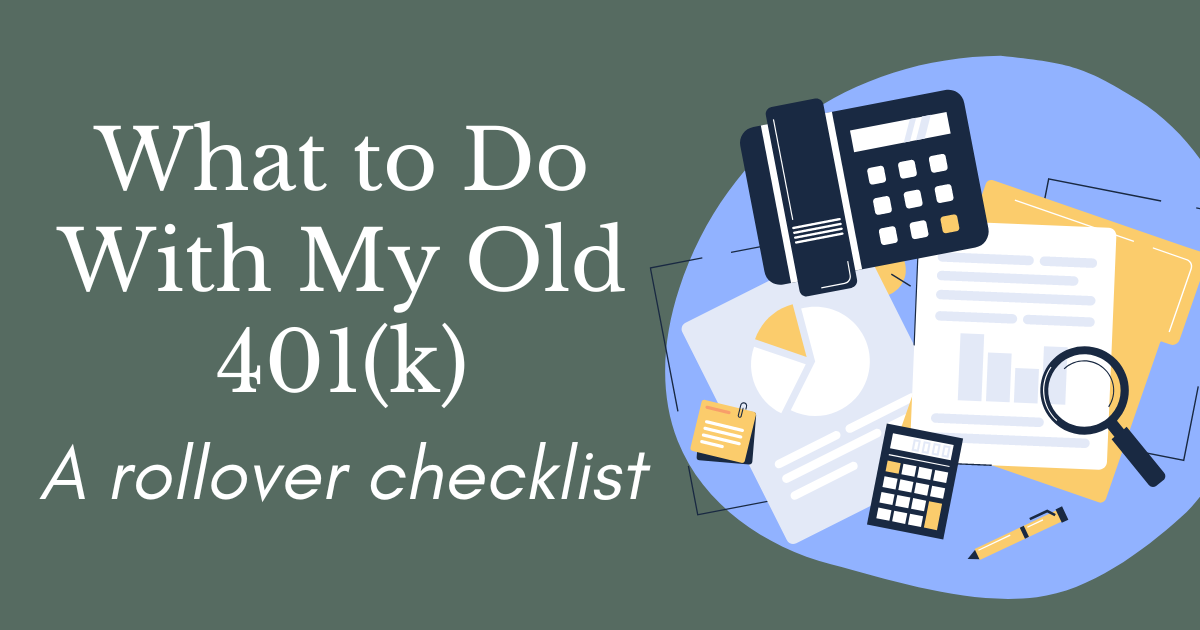Good news! The year is still young. Maybe your goals and well-intentioned resolutions have gotten off track a little, but we’re still within the first quarter, even as spring is right around the corner. Perhaps becoming more financially organized or at least more financially aware was one of your priorities this year. If so, and one of the things in the back of your mind has been an old 401(k) plan from a previous job, then hopefully you will find the advice from a recent Morningstar Financial article helpful. If not, and your (financial) house is in tip-top shape, then stick this one in your back pocket for later reference or share it with a friend.
In the article, “A 401(k) Rollover Checklist,” Morningstar’s Christine Benz presents seven steps to help you decide what to do with that dusty 401(k). We’ll recap them briefly here.
Step 1: Check the value of your account.
The amount in your 401(k) determines the breadth of options open to you. If the balance is greater than $5,000, then you can either leave the money where it is in the plan or you can roll it over into an IRA or your new 401(k), given the plan allows those choices. On the other hand, if the balance is less than $5,000, you might not have much say in what happens, though you should avoid pulling the money out, as it will be slapped with a penalty if you’re younger than 55.
Step 2: To keep the money in the 401(k) or not?
In the article, Benz notes that she often recommends moving assets from a 401(k) into a no-fee IRA, rather than keep it in a retirement plan that is sometimes saddled with high costs and fees, saying that “You can put almost anything you like within an IRA, and you’ll usually be able to avoid any administrative fees if you shop around” (Benz, 2014). However, some people prefer staying within the boundaries of the 401(k), and the options available there, and the decision comes down to personal preference and needs.
Step 3: Examine the quality of your 401(k) options.
If this is you, and you want to keep the money in the 401(k), make sure it is the best possible plan for your balance to be. Do some research into the quality of the plan, and determine whether or not to stick with the old employer’s option, or that of your new employer.
Step 4: Find the right IRA provider.
If you decided to ditch the old 401(k) and instead roll your balance to an IRA and not your new employer’s 401(k), you need to determine the best company or firm to move your account to. While there are resources that exist if you want to do your own research, this is a decision that your financial advisor could walk through with you.
Step 5: Choose whether to convert your Traditional 401(k) assets to Roth.
If you have Traditional 401(k) assets, and you roll that over either to an IRA or to your new employer’s 401(k), this is a good time to think about whether to move those to a Roth account as you do the rollover. If you made Roth 401(k) contributions, however, and you roll that money over to either an IRA or your new 401(k), that new account will also be Roth. Again, Roth means that you will not owe taxes when you go to make qualified withdrawals.
Step 6: Do it.
Once you’ve done the hard work of making all the decisions and determining where your old 401(k) will go, start the process of actually getting it done. Rollover paperwork varies based on where the money is going; it may be more complicated if rolling over to your new employer’s 401(k), for example, and you may have to wait longer or do more leg work. The important thing in any case is to make sure that the provider of your 401(k) makes the check payable to the IRA or new 401(k) provider and send it to them directly, instead of you. Otherwise, a percentage of the balance will be withheld for income tax, there will be a deadline to deposit that money, and failure to meet the deadline will end in a penalty for early withdrawal.
Step 7: Choose what to invest in.
Now that all the logistical steps are behind you, you need to determine where your assets will be invested. If you chose to rollover into a new 401(k), a solid target-date fund is the stress-free, no-sweat option. You can also take the opportunity to reassess the various pieces of your financial plan and evaluate your outlook for retirement. Either way, congratulations on finally doing something with that old 401(k). Call it spring cleaning and give yourself a pat on the back for marking something off your financial to-do list.
Benz, C. (2014, August 24). A 401(k) rollover checklist. Morningstar, Inc. Retrieved March 10, 2023, from https://www.morningstar.com/articles/662592/a-401k-rollover-checklist
A plan participant leaving an employer typically has four options (and may engage in a combination of these options), each choice offering advantages and disadvantages. For balance, please update your material to include each option below:
- Leave the money in his/her former employer’s plan, if permitted;
- Roll over the assets to his/her new employer’s plan, if one is available and rollovers are permitted;
- Roll over to an IRA; or
- Cash out the account value.
A Roth IRA offers tax deferral on any earnings in the account. Qualified withdrawals of earnings from the account are tax-free. Withdrawals of earnings prior to age 59 ½ or prior to the account being opened for 5 years, whichever is later, may result in a 10% IRS penalty tax. Limitations and restrictions may apply.
This information is not intended to be a substitute for specific individualized tax advice. We suggest that you discuss your specific tax issues with a qualified tax advisor.

